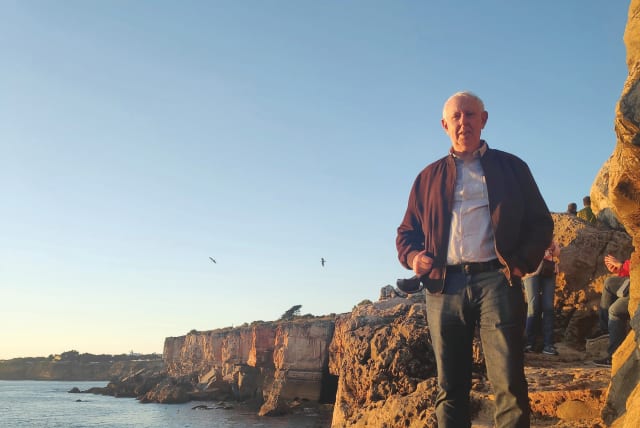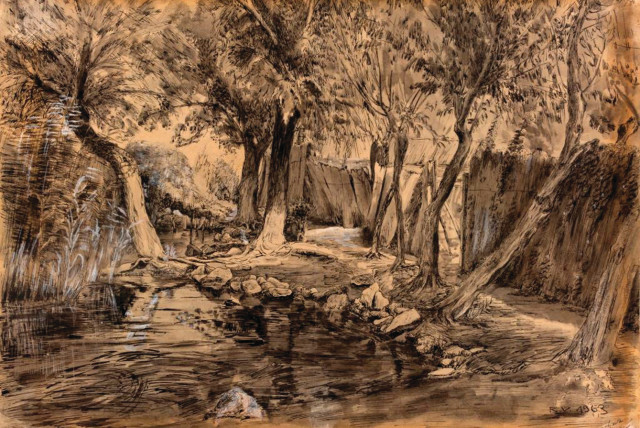Landscapes of his life

Victor Rabinovich has never regretted moving to Israel, although his landscapes have changed completely.
At the opening of his solo exhibition My Landscape at ZOA House gallery in Tel Aviv this past April, Victor Rabinovich – surrounded by family, friends and admirers of his art – said that his paintings tell stories and show landscapes of his life.
“In each work, I set myself a visual goal that I want to convey. I paint in shades and techniques that change according to this goal – the periods of my life, the space, the season, the environmental situation, and the subject. My works reflect my emotions, my love of creation and my emotional experiences,” said the 78-year-old artist, painter and architect.
His art, which he does mainly for his own pleasure, is influenced and inspired by the works of Wassily Kandinsky, Vincent van Gogh, Paul Gauguin and Paul Cézanne. When Rabinovich spoke about architecture, his primary profession, he said that the architectural works of Zaha Hadid, Frank Gehry and Moshe Safdie are very close to his heart.
The story of an Israeli artist born to Romanian Jews in the Soviet Union
Rabinovich was born to Rebeca and Nahum, Romanian Jews who escaped to the Soviet Union at the beginning of World War II. There, they were sent to Novokuznetsk [from 1932-1961 known as Stalinsk] in Siberia in 1945. His father served in the Soviet army during the war.
In 1947, the family managed to leave the cold, harsh area of Siberia and move to Ukraine (then part of the Soviet Union) to a little town close to Odesa. “Where we lived there were many Jews,” Rabinovich recalled of his childhood. “But they were not liked by others. The local hooligans called us Zyd. As used in Russian, it was an insulting way of saying ‘Jew’ as a vulgar curse. I experienced antisemitism from an early age at school, also because I was a very good student.”
His father, who was secular but, like many Jews of his times, as a little boy went to a heder [an elementary Jewish religious school for boys], wanted to pass some Jewish tradition to his three children.
“I had [a] secret bar mitzvah,” Rabinovich said.
Another example he gave was the indication of a mezuzah at their door. “There was no mezuzah itself, but there was a sign that there was once. Many Jews lived there before… ” His father kept the sign. As a sign of their past or belonging, probably.
Apart from Jewish traditions, his parents also paid attention to his natural talents and helped their young son develop his skills. “From the age of four, I was always with a pencil in my hand, drawing something,” said Rabinovich. “In my early school years, my parents sent me to many art classes [painting and general art], model building and photography.”
“At the age of 15, I entered art studies and set design for theater at a college in Odesa.” His father told him that he should learn a profession that would use his artistic skills. After four years of studies, at age 19 Rabinovich moved to Kazan in the Republic of Tatarstan (USSR), where he started to work in a theater. “I worked for three years in a very famous theater of opera and ballet in Kazan,” he recounted.
Still working at the theater, he wanted to continue his education “in the field of art and something technical. [The faculty of] architecture was not open in Kazan yet, so I decided to study mathematics.” Shortly after, he understood that beyond liking math, he was missing the art component in his studies. As soon as it was possible to study architecture, he changed the direction of his education, which was, as the future showed, a very wise move. Today, Rabinovich still works as an architect at his architectural studio in Beersheba.
After a few years in Kazan, Rabinovich went back to Odesa, already convinced that he wanted to move to Israel. “From Odesa, it seemed easier” [to move to] Israel, and he and his parents wanted to go there. But it was not simple. His parents managed to leave the Soviet Union in 1977. Rabinovich and his wife, Ina, whom he married in 1973, followed in their steps a year later.
RABINOVICH, BORN in cold Siberia, did not intend to live in the hot desert. But, as he explained, when they made aliyah in 1978, they were sent to an ulpan and were not offered a choice of resdience. Arriving from beautiful Odesa was a shock. “We came to ulpan in Beersheba. When my wife saw the desert, she was all in tears. In the dining room [of the ulpan], there was another Russian-speaking woman who was calming her down, saying that all will be beseder [all right].”
They didn’t expect back then that 45 years later they would still be in Beersheba, living in their own home, where three of their children (Ilana, David, and Eytan) and seven grandchildren visit them. Rabinovich, a new immigrant in his early 30s, probably also didn’t imagine that nearly half a century later, many buildings, including eight synagogues designed by him, would be part of the Israeli architectural landscape.
Very soon after making aliyah, he got his first job. “I didn’t finish my ulpan because already two months later I got a job as an architect. It was in a private office owned by Polish Jews; they spoke some Russian, so we could communicate.” But being raised in the Soviet Union in the time of strict communism, he was uncomfortable at a private company. “I thought private meant capitalism, and that was bad. So a few months later, I found a governmental position.”
Living in Israel changed his attitude toward ownership quickly, and in 1982 he opened his own architectural firm, which is still an ongoing concern.
Being his own boss at work gave him time for painting. “When I started my office, I always made time for painting. I just must paint. For my own pleasure. I never needed to make money from, it but it is nice when people buy my paintings,” Rabinovich said. He also emphasized that his main critic has always been his wife, with whom he just celebrated 50 years of marriage.
Even on vacation, Rabinovich doesn’t take a break from painting: “I go into a trance.” He captures landscapes, people and social scenes. “I like when something is going on in a painting, some action. The people painted are not people I see; rather, they are from my imagination.” He added, “My sources of inspiration are everywhere: classical and modern art, works of architecture, nature, and life itself.” He said he is influenced by art that conveys human emotion and soul.
At My Landscape in Tel Aviv, he also showed his early work, a painting of a market in Odesa from 1963. In his work, he uses various techniques: “I paint with oil on canvas, and I draw with crayons on paper. I also once worked in ceramics because there was no paper around.”
Rabinovich has never regretted moving to Israel, although his landscapes have changed completely. He served in two armies in his life (“I did two years in the USSR and a year and a half in Israel when I was already working”). Despite Russian being his native tongue, he speaks to his children in Hebrew (to me during the interview).
When he showed me pictures of the buildings he designed, he talked about them as if they were his children. He is very proud of his family and his achievements at work, but he is also very humble.■
Victor Rabinovich, 78, From Odesa, Ukraine (former Soviet Union), to Beersheba, 1978
Jerusalem Post Store
`; document.getElementById("linkPremium").innerHTML = cont; var divWithLink = document.getElementById("premium-link"); if (divWithLink !== null && divWithLink !== 'undefined') { divWithLink.style.border = "solid 1px #cb0f3e"; divWithLink.style.textAlign = "center"; divWithLink.style.marginBottom = "15px"; divWithLink.style.marginTop = "15px"; divWithLink.style.width = "100%"; divWithLink.style.backgroundColor = "#122952"; divWithLink.style.color = "#ffffff"; divWithLink.style.lineHeight = "1.5"; } } (function (v, i) { });

